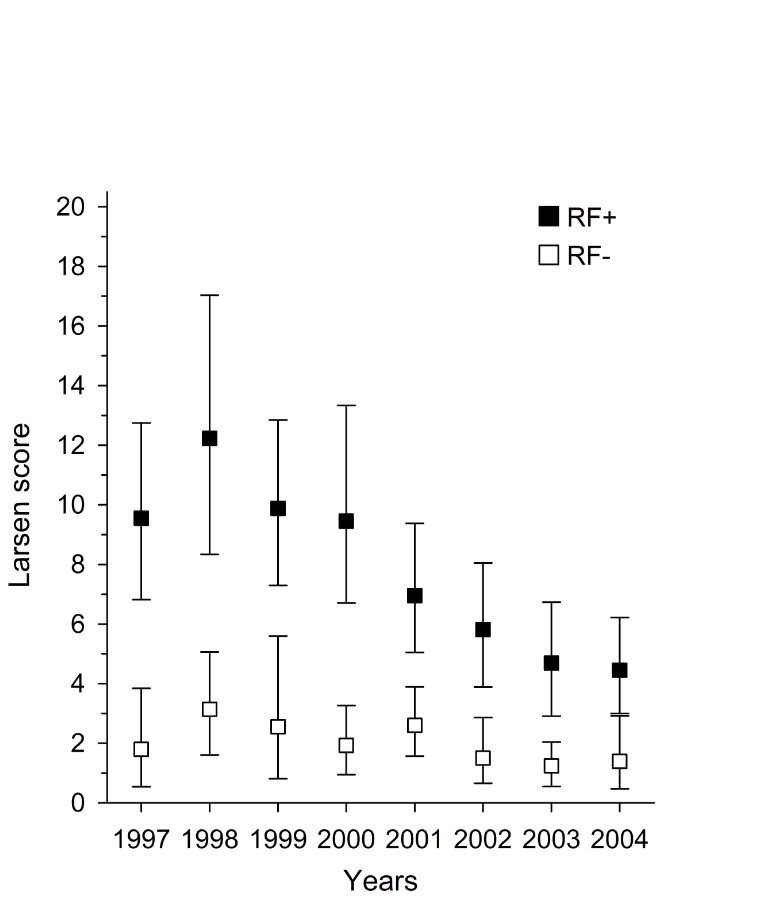Session Information
Title: Rheumatoid Arthritis - Clinical Aspects (ACR): Comorbidities, Treatment Outcomes and Mortality
Session Type: Abstract Submissions (ACR)
Background/Purpose:
Treatment of rheumatoid arthritis (RA) has improved during the last decade. Also importance of regular monitoring has been emphasized. Our objective was to study the extent of radiographic joint damage in an early RA cohort at 10 years after diagnosis.
Methods:
Our early RA cohort includes 990 patients from a single clinic with a clinical diagnosis of early RA in 1997 – 2004. Radiographs of hands and feet were taken at a 10 year follow-up visit and were analyzed according to the Larsen score (0-100) including MCP I-V, wrists, and MTP II-V. Patients were treated with the T2T strategy by a multidisciplinary care for 2 years with follow-up visits at 5 and 10 years.
Results:
Baseline characteristics of 990 patients were: the mean (SD) age 57(16) years, 67% female, 61% seropositive (RF/CCP+ any time over 10 years) and median (IQR) duration of symptoms before diagnosis 6(3, 12) months; 657(66%) patients were available for a 10 year follow up. Reasons for non-attendance among 333 patients included death (52%), high age, multi-comorbidity or institutionalization (10%), moving from the area (12%); 8% declined, 4% were lost to follow-up and 14% miscellaneous reasons. Thus, radiographs were available in 657 patients (66% seropositive); serology of one patient was missing.
At 10 years, erosions were present in 48% (314/656) patients including 61%(266/435) seropositive and 22% (48/221) seronegative patients. Among seropositive patients, Larsen score was >=10% of theoretical maximum in 28%(121/435) patients, <10% of max in 33%(145/435) patients, and 39% (169/435) remained non/erosive; for seronegative patients the corresponding figures were 5%(11/221), 17%(37/221) and 78%(173/221), respectively. The mean (SD) and median (IQR) Larsen score in seropositive patients was 7.8 (11) and 4.0 (1.0, 10), and in seronegative patients 2.0 (4.0) and 0 (0. 3). In seropositive patients, the 10-years Larsen score declined over time while in seronegative patients erosiveness remained low and stabile (figure).
Over 10 years, all patients had been taking csDMARDs, 83% had been taking systemic glucocortikoids, and 20% bDMARDs.
Conclusion:
Larsen score remained low over 10 years and erosion rates decreased over time.

Figure. Larsen score (0-100) in seropositive and negative patients with early RA diagnosed 1997-2004 at 10 years after diagnosis. Mean with bootstrap type 95 per cent confidence intervals
Disclosure:
J. Asikainen,
None;
K. Kaarela,
None;
H. Mäkinen,
None;
H. Kautiainen,
None;
P. Hannonen,
None;
T. Rannio,
None;
T. Sokka,
None.
« Back to 2014 ACR/ARHP Annual Meeting
ACR Meeting Abstracts - https://acrabstracts.org/abstract/are-erosions-a-disappearing-feature-in-rheumatoid-arthritis-rajoint-damage-in-patients-with-early-ra-at-10-years-after-diagnosis/
